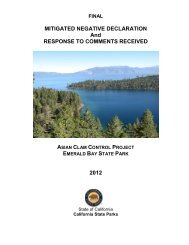Anza Borrego Desert State Park - California State Parks - State of ...
Anza Borrego Desert State Park - California State Parks - State of ...
Anza Borrego Desert State Park - California State Parks - State of ...
Create successful ePaper yourself
Turn your PDF publications into a flip-book with our unique Google optimized e-Paper software.
Final Report – October 2001<br />
Other information collected by the interviewers included: type <strong>of</strong> vehicle, date <strong>of</strong> contact,<br />
location <strong>of</strong> contact, and interviewer. As they were completed, the surveys were<br />
numbered and dated by each interviewer.<br />
Twelve hundred surveys were administered during the November sampling period. Of<br />
these, 1000 surveys (83% <strong>of</strong> total) were returned, and 853 (71% <strong>of</strong> total) were entered<br />
into the database. The same numbers <strong>of</strong> surveys was also administered during March,<br />
1100 <strong>of</strong> which (91%) were returned. One thousand, forty-one (86%) spring surveys<br />
contained valid responses and were added to the data set. The rest <strong>of</strong> the surveys were<br />
not usable for various reasons: incomplete responses, indeterminate responses, illegible<br />
writing, etc.<br />
The core aspects <strong>of</strong> the questionnaire were used at all six sample sites. One group <strong>of</strong><br />
questions, evaluating the acceptability <strong>of</strong> a range <strong>of</strong> environmental or management<br />
conditions, was specific to each site. To judge preferred park conditions, visitors were<br />
asked to view and rate the acceptability <strong>of</strong> a set <strong>of</strong> six computer-manipulated photos<br />
depicting a range <strong>of</strong> potential conditions. The conditions presented in the six scenarios<br />
were pre-selected, based on management issues and concerns communicated by <strong>Park</strong><br />
staff and by the public. In the Fish Creek and Blair Valley surveys, respondents rated the<br />
acceptability <strong>of</strong> congestion in a large campground area. Photos depicted scenarios<br />
ranging from no visible groups, to approximately 100 distinct groups. In Mountain Palm<br />
Springs and <strong>Borrego</strong> Palm Canyon, visitors rated the acceptability <strong>of</strong> a range <strong>of</strong> trail<br />
conditions, from primitive (low maintenance) to signed and paved (high maintenance and<br />
engineering). In Coyote Canyon, respondents rated the acceptability <strong>of</strong> vegetation loss<br />
due to <strong>of</strong>f-road vehicle traffic. Scenarios presented in the six photos in the Coyote<br />
Canyon series ranged from no visible impacts, to extensive vegetation loss. The Visitors’<br />
Center survey did not include questions <strong>of</strong> acceptability using the photo series.<br />
Non-participation Bias<br />
Determined efforts were made by the interviewers to encourage selected visitors to take<br />
the survey, especially those who were selected but seemed undecided about<br />
participating. Once the visitor declined however, no further effort was made.<br />
Consequently, it is possible that a degree <strong>of</strong> non-participation bias may be a factor in the<br />
results. In any case, we consider that the relatively large sample size, coupled with the<br />
randomization <strong>of</strong> sample sites, interviewers, and respondents would tend to reduce the<br />
potential for non-response bias. A response rate <strong>of</strong> 70% (non-response = 30%) is<br />
generally considered sufficient for most statistical and scientific rigor (Creswall, 1994,<br />
Keppel, 1991; Salant and Dillman, 1994). Daily tallies and anecdotal information from<br />
the interviewers suggests that the response rate in this study was greater than 70%.<br />
Data Analysis<br />
Data were coded using standard procedures and entered into a computer database.<br />
Responses for each question, or category within a composite question, were entered<br />
into the database. Fall data were entered from mid-January through mid-February 2001.<br />
Spring data were entered April 2001 and both data sets were then merged into a<br />
combined set, containing both seasons <strong>of</strong> data.<br />
9
















